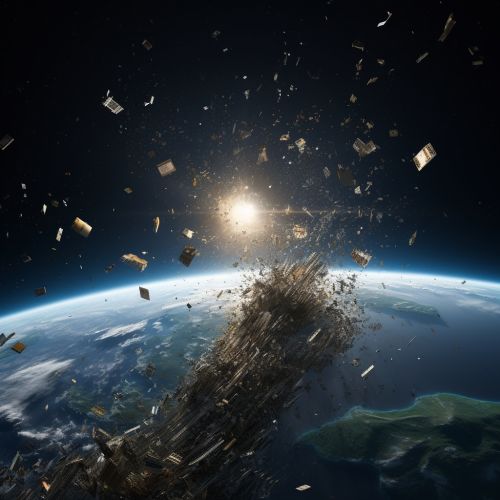The Dynamics of Space Debris and Orbital Collision Risks
Introduction
Space debris, also known as space junk, refers to defunct man-made objects in space, primarily in Earth orbit. These objects include everything from spent rocket stages and defunct satellites to fragments from disintegration, erosion, and collisions. The increasing amount of space debris in Earth's orbit poses significant risks to both manned and unmanned space missions, particularly due to the high velocities at which these objects travel. This article will delve into the dynamics of space debris and the associated risks of orbital collisions.

Space Debris Dynamics
The dynamics of space debris involves the study of the motion and behavior of these objects in space. This field of study encompasses the physical properties of the debris, the forces acting upon them, and their long-term behavior in orbit.
Physical Properties
Space debris varies greatly in size, from tiny particles of dust to large defunct satellites. The European Space Agency (ESA) estimates that there are approximately 34,000 pieces of debris larger than 10 cm, 900,000 pieces between 1 cm and 10 cm, and 128 million pieces smaller than 1 cm currently orbiting Earth.
Forces Acting on Space Debris
Several forces act on space debris, influencing their motion and behavior. These include gravitational forces, atmospheric drag, solar radiation pressure, and electromagnetic forces. The gravitational forces from the Earth, Moon, and Sun primarily determine the debris' orbit. Atmospheric drag, which affects lower orbits, can cause decay of the orbit leading to re-entry of the debris into Earth's atmosphere. Solar radiation pressure and electromagnetic forces can also perturb the orbit of the debris.
Long-Term Behavior
The long-term behavior of space debris is a subject of ongoing research. Factors such as atmospheric drag, solar activity, and collisions with other debris can influence the lifetime of space debris in orbit. Some debris re-enters the Earth's atmosphere and burns up, while others may remain in orbit for many years or even decades.
Orbital Collision Risks
The risk of collisions in space has increased with the growing amount of space debris. Even small pieces of debris can cause significant damage due to their high velocities, often over 7 km/s in low Earth orbit.
Collision Consequences
A collision in space can have serious consequences. It can lead to the total destruction of a functioning satellite or spacecraft, potentially causing a loss of service and financial loss. Additionally, collisions create more debris, exacerbating the problem of space debris.
Collision Avoidance
To mitigate the risk of collisions, several strategies are employed. These include conjunction analysis, where the paths of space objects are analyzed to predict potential collisions, and collision avoidance maneuvers, where a spacecraft changes its orbit to avoid a potential collision. Active debris removal, where debris is intentionally removed from orbit, is also being explored as a future strategy.
Kessler Syndrome
The Kessler Syndrome, proposed by NASA scientist Donald J. Kessler in 1978, is a scenario in which the density of objects in low Earth orbit is high enough that collisions between objects could cause a cascade effect, where each collision generates more debris, leading to a higher likelihood of further collisions. This could potentially render space activities and the use of satellites in specific orbital ranges difficult for many generations.
Conclusion
The dynamics of space debris and the associated risks of orbital collisions are complex issues that require ongoing research and management. As our reliance on space-based technologies grows, so too does the importance of understanding and mitigating the risks posed by space debris.
